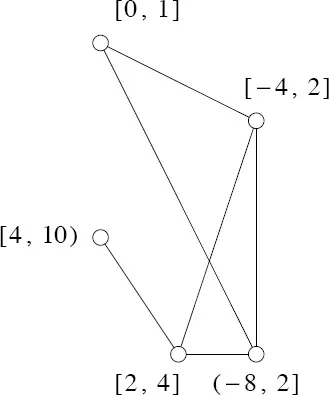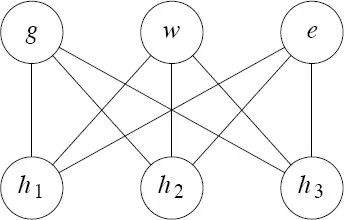
eBook - ePub
Graph Theory
Ronald Gould
This is a test
Compartir libro
- 352 páginas
- English
- ePUB (apto para móviles)
- Disponible en iOS y Android
eBook - ePub
Graph Theory
Ronald Gould
Detalles del libro
Vista previa del libro
Índice
Citas
Información del libro
This introduction to graph theory focuses on well-established topics, covering primary techniques and including both algorithmic and theoretical problems. The algorithms are presented with a minimum of advanced data structures and programming details. This thoroughly corrected 1988 edition provides insights to computer scientists as well as advanced undergraduates and graduate students of topology, algebra, and matrix theory.
Fundamental concepts and notation and elementary properties and operations are the first subjects, followed by examinations of paths and searching, trees, and networks. Subsequent chapters explore cycles and circuits, planarity, matchings, and independence. The text concludes with considerations of special topics and applications and extremal theory. Exercises appear throughout the text.
Fundamental concepts and notation and elementary properties and operations are the first subjects, followed by examinations of paths and searching, trees, and networks. Subsequent chapters explore cycles and circuits, planarity, matchings, and independence. The text concludes with considerations of special topics and applications and extremal theory. Exercises appear throughout the text.
Preguntas frecuentes
¿Cómo cancelo mi suscripción?
¿Cómo descargo los libros?
Por el momento, todos nuestros libros ePub adaptables a dispositivos móviles se pueden descargar a través de la aplicación. La mayor parte de nuestros PDF también se puede descargar y ya estamos trabajando para que el resto también sea descargable. Obtén más información aquí.
¿En qué se diferencian los planes de precios?
Ambos planes te permiten acceder por completo a la biblioteca y a todas las funciones de Perlego. Las únicas diferencias son el precio y el período de suscripción: con el plan anual ahorrarás en torno a un 30 % en comparación con 12 meses de un plan mensual.
¿Qué es Perlego?
Somos un servicio de suscripción de libros de texto en línea que te permite acceder a toda una biblioteca en línea por menos de lo que cuesta un libro al mes. Con más de un millón de libros sobre más de 1000 categorías, ¡tenemos todo lo que necesitas! Obtén más información aquí.
¿Perlego ofrece la función de texto a voz?
Busca el símbolo de lectura en voz alta en tu próximo libro para ver si puedes escucharlo. La herramienta de lectura en voz alta lee el texto en voz alta por ti, resaltando el texto a medida que se lee. Puedes pausarla, acelerarla y ralentizarla. Obtén más información aquí.
¿Es Graph Theory un PDF/ePUB en línea?
Sí, puedes acceder a Graph Theory de Ronald Gould en formato PDF o ePUB, así como a otros libros populares de Mathematics y Discrete Mathematics. Tenemos más de un millón de libros disponibles en nuestro catálogo para que explores.
Información
Categoría
MathematicsCategoría
Discrete MathematicsChapter 1
Graphs
Section 1.0 Introduction
For years, mathematicians have affected the growth and development of computer science. In the beginning they helped design computers for the express purpose of simplifying large mathematical computations. However, as the role of computers in our society changed, the needs of computer scientists began affecting the kind of mathematics being done.
Graph theory is a prime example of this change in thinking. Mathematicians study graphs because of their natural mathematical beauty, with relations to topology, algebra and matrix theory spurring their interest. Computer scientists also study graphs because of their many applications to computing, such as in data representation and network design. These applications have generated considerable interest in algorithms dealing with graphs and graph properties by both mathematicians and computer scientists.
Today, a study of graphs is not complete without at least an introduction to both theory and algorithms. This text will attempt to convince you that this is simply the nature of the subject and, in fact, the way it was meant to be treated.
Section 1.1 Fundamental Concepts and Notation
Graphs arise in many settings and are used to model a wide variety of situations. Perhaps the easiest way to adjust to this variety is to see several very different uses immediately. Initially, let’s consider several problems and concentrate on finding models representing these problems, rather than worrying about their solutions.
Suppose that we are given a collection of intervals on the real line, say C = { I1, I2, . . . , Ik}. Any two of these intervals may or may not have a nonempty intersection. Suppose that we want a way to display the intersection relationship among these intervals. What form of model will easily display these intersections?
One possible model for representing these intersections is the following: Let each interval be represented by a circle and draw a line between two circles if, and only if, the intervals that correspond to these circles intersect. For example, consider the set
C = { [−4, 2], [0, 1], (−8, 2], [2, 4], [4, 10) }.
The model for these intervals is shown in Figure 1.1.1.

Figure 1.1.1. A model for the intersections of the members of C.
Next, we consider the following old puzzle. Suppose there are three houses (call them h1, h2 and h3) and three utility companies (say gas (g), water (w) and electricity (e)). Our problem is to determine if it is possible to connect each of the three houses to each of the three utilities without crossing the service lines that run from the utilities to the houses. We model this puzzle by representing each house and each utility as a circle and drawing a line between two circles if there is a service line between the corresponding house and utility. We picture this situation in Figure 1.1.2. A solution to this problem would be a drawing in which no lines crossed. The drawing of Figure 1.1.2 is not a solution to the problem, but merely an attempt at modeling the problem.

Figure 1.1.2. The three houses and three utilities model.
In our third problem, suppose you are the manager of a company that has four job openings (say j1, j2, j3 and j4) and five applicants a1, . . . , a5 and that some of these applicants are qualified for more than one of your jobs. How do you go about choosing people to fill the jobs so that you will fill as many openings as possible? We picture such a situation in Figure 1.1.3. Again, each job and each applicant can be represented as a circle. This time, a line is drawn from a circle represe...